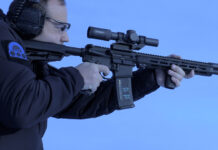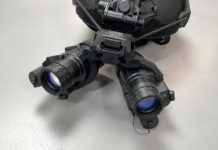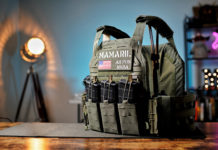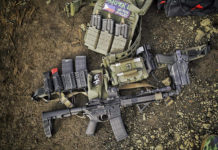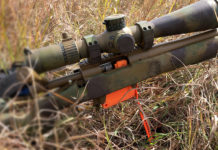[dcs_img_center desc=”Photo Credit: Chris Tran”
framed=”black” w=”600″ h=”400″]
http://gunsandtactics.wpengine.com/wp-content/uploads/2016/12/TRAN_ZeroBravo_REOS-0017.jpg
[/dcs_img_center]
[dcs_post_top]
[dcs_fancy_header bgcolor=”#ffffff” color=”#000000″ fweight=”bold”]REOS… the next-gen BUIS[/dcs_fancy_header]
[dcs_thinspliter size=”medium”]
Over the past few months, far more learned and experienced shooters than me have discussed the viability of variable-powered optics as a primary and singular optic for carbine use. SF guys such as Frank Proctor, whom I hold in very high esteem, have even dedicated complete articles discussing the use of a variable powered scope in combat and competition without the use of a BUIS system; citing changes in shooting styles and additional sighting system management, as well as practical experience in the field that may in fact render the use of a BUIS system as obsolete. Frank discussed the reality of his and others’ wartime experience of not having a scope actually fail to the point where he needed to switch to a BUIS system, as well as proper scope placement and stock LOP for more effective ergonomics, for an argument against using BUIS as a redundant sighting system.
I am nowhere near the caliber of a shooter as Frank, both in practical application and experience, so I’m not one to discount his learned position, and even in my own training and experience as a domestic police officer we train to " shoot through the tube" for close quarter situations in the eventuality our primary optic, in my case an Aimpoint M4 on a Colt 14.5" carbine, failed at a crucial moment. Accuracy drills solely using the tube of an Aimpoint M4 demonstrate that multiple combat effective " good enough" COM shots can be achieved, but get a little dodgy past 15 yards.
For those of us whose equipment decisions are dictated by agency policy or firm belief in Murphy’s Law, BUIS systems may still be a reality that we must deal with. In keeping with the mindset that scope placement and proper shooting ergonomics are of tantamount importance, there are several BUIS companies out there that can address rail real estate and scope clearance issues. My all-time favorite would of course be the Low Rider sights from Bobro Engineering. The Low Riders are incredibly slim, less than three stacked quarters in height when folded down, and were designed specifically to fit under not only the rear objective lens of a mounted scope, but under the front portion of the scope mount as well to the rearmost section of the rail, leaving real estate up front for a DBAL and white light. Of course, then to deploy the Low Riders, the user must get rid of the scope; meaning that the scope must be mounted in a detachable scope mount, and the user is willing to sacrifice or stow the failed optic. Time and circumstance may not allow for that option.
The simplest solution would of course be to simply transition to a secondary firearm if an exigent circumstance arose where the user’s primary weapon optic was out of the fight, but if time is of the essence and the situation dictated, staying with the primary firearm and having an alternative sighting system, such as an offset BUIS system may be the most expedient and effective method to engage and get rounds on a hostile subject.
45° offset irons or Rapid Deploy Sights (RDS) are immediate options, but I don’t like fixed offset irons due to how far they extend off of the top rail, in most cases with notable exceptions they’re not lefty-friendly, and I’m too cheap to buy a RDS solely for a secondary sighting system.
My friend and competitive shooter Craig Outzen got me hooked up with Todd Tuttle from Zero Bravo, who created a super simple and intuitive BUIS system dubbed the Rapid Engagement Offset Sight, or REOS.
The REOS is an "old is new" sighting system comprised of two simple ghost ring sights that clamp onto the tube of the variable powered optic, and there are models that will fit standard 30mm, 34mm, and 1" scope diameters. It is a simple, intuitive sighting system that proved to be worth a closer look.
The REOS sights are fashioned from 6160 aluminum and Type III Hardcoat Anodized. The two sight rings are identical in design and execution and are truly ambidextrous for both left, and right handed shooters.
[dcs_blockquote margin=”12px 24px 12px 24px” color=”#999999″]"..an offset BUIS system may be the most expedient and effective method to engage and get rounds on a hostile subject."[/dcs_blockquote]
The two-piece sights clamp onto the tube of the scope, and the end user angles them canting downward, so that the sights clear the windage knob of the scope for right handed shooters. For left-handers like me, simply reverse the process and orient the rings down and to the left, allowing for quick engagement by simply canting the rifle inboard to line up the sights.
Sighting is easy and intuitive; simply line up the rings and orient on your aiming point through the tubes – which is a nice change from standard circle and post sights, in that the intended target is fully visible in the sight picture. Todd recommends painting the front sight ring which allows for faster orientation of the apertures.
I mounted my evaluation set of REOS sights with ease, and was off to the range to zero them in and to see how they worked.
The Rundown
Once at the range, I admit I was a bit skeptical. I had positioned the REOS to fit my body and natural inboard cant. I started off at 50 yards, and that was a no-go, the distance at 50 yards is too much (for me) to get a reliable and consistent sight picture to get any kind of recordable group. I moved in to 25 yards, and within a few test groupings, was actually quite surprised to be able to record 2" groups – more than accurate for a quick "minute of man" snapshot combat-effective groups.
Once I moved in to 10 yards, I was consistently achieving 1" – 1.5" groups. I’m not talking measured, controlled breathing shots, but quick, rapid-succession shots as if I was squeezing off rounds with a sense of urgency if my scope had been occluded or rendered inoperable. What surprised me even further in retrospect is that I didn’t even think to factor in traditional sight offset as I would be required to do with a red dot or through a scope – I simply pressed off my shots and they impacted where I wanted them to go.
Color me impressed.
[dcs_img_center desc=”Photo Credit: Chris Tran”
framed=”black” w=”600″ h=”400″]
http://gunsandtactics.wpengine.com/wp-content/uploads/2016/12/TRAN_ZeroBravo_REOS-0014.jpg
[/dcs_img_center]
Initial Thoughts and Evaluation
In totality, the REOS sights simply work. Stacking the REOS against similar sights, here are some things to consider. The REOS sights weigh in at a scant 2 ounces, compared to other popular options such as the Magpul 45° offset sights that weight in a 1.8 oz, but the REOS are about $20 more. The next obvious comparison would be famed Duek Defense Rapid Offset Sights, which are twice as expensive and are configured more towards traditional sight construction, but at a 45 degree offset. The Knights Armament offset sights are well over 2x as expensive as the REOS, and are specifically configured for right-handed shooters only.
Taking these three comparison sighting systems into consideration, the REOS are competitively priced, less snag-resistant, less moving parts to adjust/break, and don’t require any action to deploy.
All in all, I find the REOS sights to be a viable BUIS system, and competitively priced. Add the ability to be able to use the sights at combat-effective CQB distances without having to take any additional steps to deploy the sights other than canting the rifle inboard, and they are a clear-cut winner.
I will definitely purchase my evaluation set instead of sending them back, and have no regrets doing so.
[dcs_img_center desc=”Photo Credit: Chris Tran”
framed=”black” w=”600″ h=”238″]
http://gunsandtactics.wpengine.com/wp-content/uploads/2016/12/TRAN_ZeroBravo-REOS-2687.jpg
[/dcs_img_center]
[dcs_thinspliter size=”medium”]
Want to know more about about Zero Bravo? Check them out at zerobravo.com, Facebook, or Instagram.
[dcs_thinspliter size=”medium”]
Check out Chris Tran on Facebook and Instagram.
[dcs_thinspliter size=”medium”]
* The views and opinions expressed on this web site are solely those of the original authors and contributors. These views and opinions do not necessarily represent those of Guns & Tactics Magazine,
the administrative staff, and/or any/all contributors to this site.
[dcs_rounded_box padding=”15px” margin=”24px 0px 0px 0px”]
Want more posts like this one? Subscribe to Guns & Tactics Magazine to receive email updates and special offers direct to your inbox!
[/dcs_rounded_box]
[dcs_post_bottom]
[dcs_post_author]
[dcs_related_posts]
[dcs_thinspliter size=”medium”]




